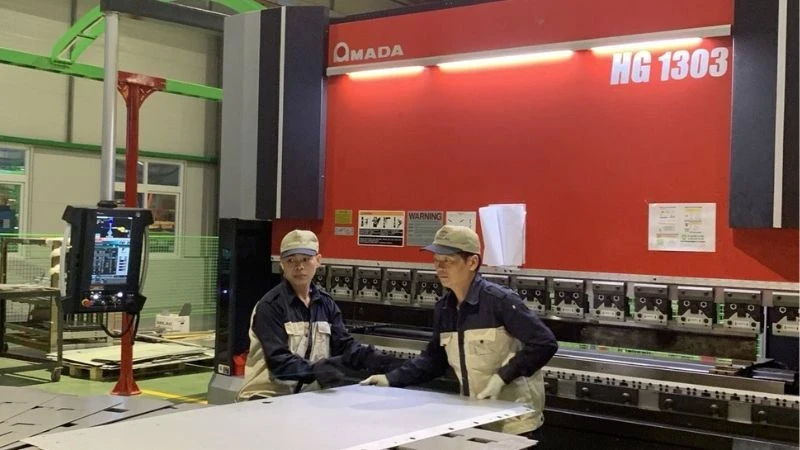Based on this set of indicators, policymakers and local leaders will have a basis to determine and choose appropriate directions and solutions for the socio-economic development of their localities based on science, technology and innovation.
According to the announced results, the ten leading localities in terms of innovation at the local level in 2023 are Hanoi (first position), Ho Chi Minh City (second), Hai Phong (third), Da Nang (fourth), Can Tho (fifth), Bac Ninh (sixth), Ba Ria – Vung Tau (seventh), Binh Duong (eighth), Quang Ninh (ninth) and Thai Nguyen (tenth).
The localities with low innovation index include Cao Bang, Lai Chau, Gia Lai, Ha Giang, Dien Bien, Yen Bai, Son La, Bac Kan, Quang Tri and Dak Nong.
According to experts, the common characteristics of the leading localities in terms of innovation are the large scale, developed economy, high per capita income, complete infrastructure, abundant human capital and number of businesses.
Among them, centrally run cities (Hanoi, Ho Chi Minh City, Hai Phong, Da Nang and Can Tho) are important military, political, cultural and economic areas. The remainder are localities with developed industries, attracting and gathering large industrial parks across the country. Therefore, open supportive policies are a favourable environment for businesses to innovate.
However, each locality has its highlights when “measured” by the Innovation Index. Hanoi achieved perfect scores in the components of human resources for research and development as well as the spending for this activity. The rate of businesses with investment in innovation in the capital city also reached 100 points.
Regarding output, the number of intellectual properties (patents and utility solutions) is among the top in the country. Hanoi also has a specific policy in attracting foreign investment, focusing on large-scale and high-quality projects.
Ho Chi Minh City recorded a perfect score in terms of policies to support small and medium-sized enterprises, digital infrastructure and the proportion of businesses with research and development activities. Hai Phong’s highlight lies in its policy of promoting science, technology, and innovation for socio-economic development.
The local innovation index set has 52 indicators, divided into seven pillars (according to the principles of the Global Innovation Index). Of these, five input pillars reflect the factors that create favourable conditions for socio-economic development based on science, technology and innovation, including mechanisms; human capital and research and development; the infrastructure; market development level; and the businesses’ development level.
The two output pillars reflecting the impact of science, technology and innovation on socio-economic development are knowledge, creativity and technology products and impact.
The Ministry of Science and Technology said that international experts introduced by the World Intellectual Property Organisation (WIPO) have assessed that the local innovation index set can meet international quality standards in terms of statistics and methodology.
The calculation process has clear steps and closely follows the process of the Global Innovation Index, based on best practices applied by the European Commission, the United Nations and several other international organisations.
Data used to build the set Provincial Innovation Index has been taken from two main sources, including statistics and State management data, officially announced from ministries, state management agencies and central organisations (with 39/52 indicators), and those that are collected and provided by localities accompanied with supporting documents (with 13/52 indicators).
By designing indicators appropriate to the practical context and characteristics of localities, the Ministry of Science and Technology hopes to help localities see strengths, weaknesses, potential factors and necessary conditions to promote socio-economic development based on science, technology and innovation.
Highlighting the necessity of the Provincial Innovation Index, Minister of Science and Technology Huynh Thanh Dat said many important documents of the Party and Government have affirmed the need to quickly transform the country’s growth model towards "gradually shifting from relying on the increase of the number of input factors for production to relying on increasing productivity, labour quality, and applying science, technology and innovation".
To form and transform into a growth model based on science, technology and innovation, quantitative descriptions are needed to help visualise and concretise into specific goals and targets. Therefore, the provincial innovation index set aims to describe the current status of the local socio-economic development model based on science, technology and innovation.
With differences between localities in terms of socioeconomic scale, population, land, economic structure and development orientation, the localities need to choose a socio-economic development model based on different science, technology and innovation, in line with the context, conditions and unique characteristics of their localities. Therefore, the Provincial Innovation Index helps local leaders to direct and operate better and closer to reality.
In addition, at the national level, since 2017, the Government has used the Global Innovation Index (GII) published annually by the WIPO. The Global Innovation Index identifies the strengths and weaknesses of the countries, thereby providing appropriate improvement solutions as well as promptly developing and promulgating relevant policies.
However, at the local level, many places are still confused about participating in the implementation process of the Government's Resolution on improving the national innovation index. One of the reasons is the lack of similar statistics at the local level. The development of the Provincial Innovation Index also overcomes this shortcoming.
Emphasising the exploitation and use of the Innovation Index for the direction, administration, and socio-economic development activities, the experts noted that the comparisons of scores among the localities should not be too heavy because the strengths or weaknesses of a locality are sometimes only relative factors.
For example, for a locality that relies on tourism or agriculture, its weakness in industry is very normal. Therefore, each locality has different development orientations, so the exploitation of this set of indicators is also different.
In addition to providing a scientific basis and evidence of strengths and weaknesses, potential factors and necessary conditions for socio-economic development based on science, technology and innovation of each locality, the Provincial Innovation Index is also a useful reference in terms of the local investment environment to help investors and businesses make appropriate decisions.
















